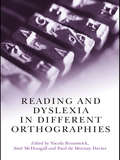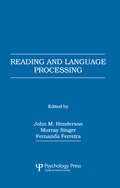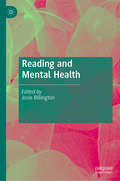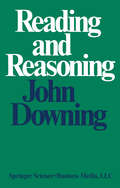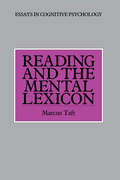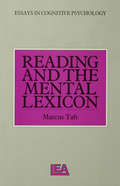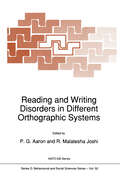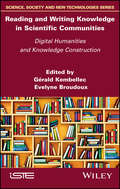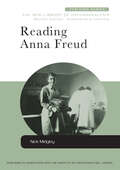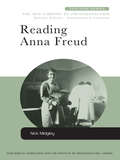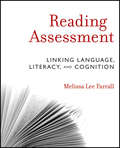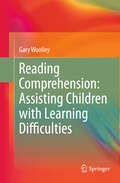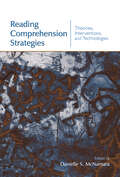- Table View
- List View
Reading and Dyslexia in Different Orthographies
by Nicola BrunswickThis book provides a unique and accessible account of current research on reading and dyslexia in different orthographies. While most research has been conducted in English, this text presents cross-language comparisons to provide insights into universal aspects of reading development and developmental dyslexia in alphabetic and non-alphabetic languages. The book brings together contributions from a group of leading literacy researchers from around the world. It begins by examining the development of language skills in monolingual speakers of alphabetic and non-alphabetic languages; it then explores literacy acquisition in bilingual children learning to read in languages with different spelling-sound rules, including English, French, Greek, Welsh and Japanese. The second section is devoted to developmental dyslexia in monolingual and bilingual speakers of different languages and examines the impact of variations in orthography on the symptoms and aetiology of dyslexia. The final section explores the contribution of brain imaging to the study of impaired and unimpaired reading, giving an up-to-the-minute picture of how the brain deals with different languages and writing systems. This is ideal reading for advanced undergraduates and postgraduates who have an interest in language acquisition, reading and spelling, as well as speech and language therapists, teachers and special educational needs professionals.
Reading and Dyslexia in Different Orthographies
by Nicola Brunswick Sine McDougall Paul De Mornay DaviesThis book provides a unique and accessible account of current research on reading and dyslexia in different orthographies. While most research has been conducted in English, this text presents cross-language comparisons to provide insights into universal aspects of reading development and developmental dyslexia in alphabetic and non-alphabetic languages. The book brings together contributions from a group of leading literacy researchers from around the world. It begins by examining the development of language skills in monolingual speakers of alphabetic and non-alphabetic languages; it then explores literacy acquisition in bilingual children learning to read in languages with different spelling-sound rules, including English, French, Greek, Welsh and Japanese. The second section is devoted to developmental dyslexia in monolingual and bilingual speakers of different languages and examines the impact of variations in orthography on the symptoms and aetiology of dyslexia. The final section explores the contribution of brain imaging to the study of impaired and unimpaired reading, giving an up-to-the-minute picture of how the brain deals with different languages and writing systems. This is ideal reading for advanced undergraduates and postgraduates who have an interest in language acquisition, reading and spelling, as well as speech and language therapists, teachers and special educational needs professionals.
Reading and Expressive Writing with Traumatised Children, Young Refugees and Asylum Seekers: Unpack My Heart with Words (Writing for Therapy or Personal Development)
by Marion BaraitserDrawing on the author's work with young asylum seekers and refugees, this book explores how literature can be used to help children and young people who have been victims of violence overcome their experiences and regain self-worth. It covers all aspects of implementing the therapy, including the theory behind it and practical advice.
Reading and Language Processing
by John M. Henderson Murray Singer Fernanda FerreiraThis volume was designed to identify the current limits of progress in the psychology of reading and language processing in an information processing framework. Leaders in their fields of interest, the chapter authors couple current theoretical analyses with new, formally presented experiments. The research -- cutting-edge and sometimes controversial -- reflects the prevailing analysis that language comprehension results in numerous levels of representation, including surface features, lexical properties, linguistic structures, and idea networks underlying a message as well as the situations to which a message refers. As a group, the chapters highlight the impact that input modality -- auditory or written -- has on comprehension. Finally, the studies also capture the evolution of new topic matter and ongoing debates concerning the competing paradigms, global proposals, and methods that form the foundation of the enterprise. The book presents current accounts of research on word-, sentence-, and text-processing. It will prove informative for experimental psychologists as well as investigators in cognitive science disciplines such as computer science, linguistics, and educational psychology. The book will also be very helpful to graduate students who wish to develop expertise in the psychology of language processes. For them, it collects, in a single volume, readings that are representative of progress concerning many central problems in the field. As such, it is distinct from the numerous collected volumes that concentrate on a single issue. Complete author and subject indexes facilitate effective use of the volume.
Reading and Language Processing
by John M. Henderson Murray Singer Fernanda FerreiraThis volume was designed to identify the current limits of progress in the psychology of reading and language processing in an information processing framework. Leaders in their fields of interest, the chapter authors couple current theoretical analyses with new, formally presented experiments. The research -- cutting-edge and sometimes controversial -- reflects the prevailing analysis that language comprehension results in numerous levels of representation, including surface features, lexical properties, linguistic structures, and idea networks underlying a message as well as the situations to which a message refers. As a group, the chapters highlight the impact that input modality -- auditory or written -- has on comprehension. Finally, the studies also capture the evolution of new topic matter and ongoing debates concerning the competing paradigms, global proposals, and methods that form the foundation of the enterprise. The book presents current accounts of research on word-, sentence-, and text-processing. It will prove informative for experimental psychologists as well as investigators in cognitive science disciplines such as computer science, linguistics, and educational psychology. The book will also be very helpful to graduate students who wish to develop expertise in the psychology of language processes. For them, it collects, in a single volume, readings that are representative of progress concerning many central problems in the field. As such, it is distinct from the numerous collected volumes that concentrate on a single issue. Complete author and subject indexes facilitate effective use of the volume.
Reading and Mental Health
by Josie BillingtonThis book brings together into one edited volume the most compelling rationales for literary reading and health, the best current practices in this area and state of the art research methodologies. It consolidates the findings and insights of this burgeoning field of enquiry across diverse disciplines and groups: psychologists, neurologists, and social scientists; literary scholars, writers and philosophers; medical researchers and practitioners; reading charities and arts organisations. Following introductory chapters on the literary-historical background to reading and health, the book is divided into four key sections. The first part focuses on Practices, showcasing reading interventions and cultures in clinical and community mental health care and in secure settings. This is followed by Research Methodologies, featuring innovative qualitative and quantitative approaches, and by a section covering Theory, with chapters from eminent thinkers in psychiatry, psychology and psychoanalysis. The final part is concerned with Implementation, incorporating perspectives from health professionals, commissioners and reading practitioners.This innovate work explains why reading matters in health and wellbeing, and offers a foundational text to future scholars in the field and to health professionals and policy-makers in relation to the embedding of reading practices in professional health care.
Reading and Reasoning
by DOWNINGI have written this book to put forward a new theory of reading the cognitive clarity theory. But the book is not all theory. I have tried to show how this theory can help students, teachers and parents to improve children's education in reading at home and at school. Although the cognitive clarity theory is new, it is derived from other theories and from a wide range of educational, linguistic and psychological research. The cognitive clarity theory is thus a bringing together of the insights of many col leagues in these disciplines. What the theory owes to these colleagues is clearly acknowledged as the evidence is presented. But I must also be thankful for the experiences that have led me in this direction. I worked as a school teacher for nearly ten years before I became an experimental psychologist. During my years as a teacher I was often baffled by children's difficulties in learning to read. Then, only two or three years after qualifying in psych ology, I had the good fortune to be chosen to plan and conduct the first large scale experiment on children's reading in Britain.
Reading and the Mental Lexicon (Essays in Cognitive Psychology)
by Marcus TaftOver the last twenty years a major area of cognitive psychology has developed centred upon research into the issues of how visually presented words are processed so that they can be read and understood. The focus has been on how words are stored in the mental lexicon and retrieved during the reading process. If we possessed no mental lexicon, we would be unable to read. This book dedicates itself to a critical evaluation of the ideas that have emerged from this body of research. The text outlines the major models of lexical processing that have been put forward in the literature, and how they explain the basic empirical findings that have been reported. It then goes on to consider the possible influence that sentential context has on lexical processing, the impact of the pronunciation of a word on its visual processing, and the role played by internal word structure (i.e., syllables and morphemes) in the recognition of a word. A connectionist style model emerges during the course of the evaluation of these issues.This book is suitable for advanced students and researchers, and is intended to serve as a springboard for discussion and an inspiration for empirical research.
Reading and the Mental Lexicon (Essays in Cognitive Psychology)
by Marcus TaftOver the last twenty years a major area of cognitive psychology has developed centred upon research into the issues of how visually presented words are processed so that they can be read and understood. The focus has been on how words are stored in the mental lexicon and retrieved during the reading process. If we possessed no mental lexicon, we would be unable to read. This book dedicates itself to a critical evaluation of the ideas that have emerged from this body of research. The text outlines the major models of lexical processing that have been put forward in the literature, and how they explain the basic empirical findings that have been reported. It then goes on to consider the possible influence that sentential context has on lexical processing, the impact of the pronunciation of a word on its visual processing, and the role played by internal word structure (i.e., syllables and morphemes) in the recognition of a word. A connectionist style model emerges during the course of the evaluation of these issues.This book is suitable for advanced students and researchers, and is intended to serve as a springboard for discussion and an inspiration for empirical research.
Reading and Writing Disorders in Different Orthographic Systems (NATO Science Series D: #52)
by P. G. Aaron and R. Malatesha JoshiEven though Specific Reading Disability (Dyslexia) has been clinically recognized as a developmental learning disorder for nearly a hundred years. only within the past two decades it has become the subject of major experimental investigation. Because. by definition. dyslexic children are of average or superior intelligence. it is often suspected that some arcane feature of the written language is responsible for the inordinate difficulty experienced by these children in learning to read. The occasional claim that developmental dyslexia is virtually nonexistent in some languages coupled with the fact that languages differ in their writing systems has further rendered orthography a subject of serious investigation. The present Volume represents a collection of preliminary reports of investigations that explored the relationship between orthography and reading disabilities in different languages. Even though not explicitly stated. these reports are concerned with the question whether or not some orthographies are easier to learn to read and write than others. One dimension on which orthographies differ from each other is the kind of relationship they bear to pronunciation. The orthographies examined in this book range from the ones that have a simple one-to one grapheme-phoneme relationship to those which have a more complex relationship.
Reading and Writing Knowledge in Scientific Communities: Digital Humanities and Knowledge Construction
by Gérald Kembellec Evelyne BroudouxPractices associated with the culture of “scholarly” reading have been developed over many centuries and annotations themselves have become the subject of study, either as additional elements in connection with the original texts or as documents in their own right. The first “scholarly” reading techniques, seen historically from the 12th Century onwards, combine reading and writing in a process known as lettrure, involving both attentive reading and commentary. The Internet has transformed this activity, adding technical layers that relate both to the reading and writing process as well as to the circulation of texts; their potential and effective augmentation, diffusion, and reception. This book examines digitized reading and writing by focusing primarily on the conditions for the co-construction of scientific knowledge and its augmentation. The authors present numerous examples of studies and personal feedback concerning the intellectual process, open critical spaces, collaborative scholarly publishing, methods for the circulation and mediatization of knowledge, as well as the techniques and tools employed.
Reading and Writing Knowledge in Scientific Communities: Digital Humanities and Knowledge Construction
by Gérald Kembellec Evelyne BroudouxPractices associated with the culture of “scholarly” reading have been developed over many centuries and annotations themselves have become the subject of study, either as additional elements in connection with the original texts or as documents in their own right. The first “scholarly” reading techniques, seen historically from the 12th Century onwards, combine reading and writing in a process known as lettrure, involving both attentive reading and commentary. The Internet has transformed this activity, adding technical layers that relate both to the reading and writing process as well as to the circulation of texts; their potential and effective augmentation, diffusion, and reception. This book examines digitized reading and writing by focusing primarily on the conditions for the co-construction of scientific knowledge and its augmentation. The authors present numerous examples of studies and personal feedback concerning the intellectual process, open critical spaces, collaborative scholarly publishing, methods for the circulation and mediatization of knowledge, as well as the techniques and tools employed.
Reading Anna Freud (New Library of Psychoanalysis Teaching Series)
by Nick MidgleyWhat place do Anna Freud’s ideas have in the history of psychoanalysis? What can her writings teach us today about how to work therapeutically with children? Are her psychoanalytic ideas still relevant to those entrusted with the welfare of infants and young people? Reading Anna Freud provides an accessible introduction to the writings of one of the most significant figures in the history of psychoanalysis. Each chapter introduces a number of her key papers, with clear summaries of the main ideas, historical background, a discussion of the influence and contemporary relevance of her thinking, and recommendations for further reading. Areas covered include Anna Freud’s writings on: • The theory and practice of child analysis and 'developmental therapy'• The application of psychoanalytic thinking to education, paediatrics and the law• The assessment and diagnosis of childhood disorders• Psychoanalytic research and developmental psychopathology Nick Midgley draws on his extensive experience as a child psychotherapist and a teacher to bring Anna Freud's ideas to life. He illustrates the remarkable originality of her thinking, and shows how analytic ideas can be used not only in child psychotherapy, but also to inform the care of children in families, hospitals, classrooms, residential care and the court-room. Reading Anna Freud will be of interest to child therapists, child analysts and psychoanalysts, as well as others working in the field of child and adolescent mental health, such as clinical psychologists, child psychiatrists and educational psychologists. It also has much to offer to those entrusted with the care of children in a wide range of settings - including teachers, nurses and social workers - for whom Anna Freud was always keen to demonstrate the value of a psychoanalytic approach. Nick Midgley trained as a child and adolescent psychotherapist at the Anna Freud Centre, where he now works as a clinician and as Programme Director for the MSc in Developmental Psychology and Clinical Practice. Nick has written articles on a wide range of topics and is joint editor of Minding the Child: Mentalization-based Interventions with Children, Young People and their Families (Routledge, 2012) and Child Psychotherapy and Research: New Directions, Emerging Findings (Routledge, 2009).
Reading Anna Freud (New Library of Psychoanalysis Teaching Series)
by Nick MidgleyWhat place do Anna Freud’s ideas have in the history of psychoanalysis? What can her writings teach us today about how to work therapeutically with children? Are her psychoanalytic ideas still relevant to those entrusted with the welfare of infants and young people? Reading Anna Freud provides an accessible introduction to the writings of one of the most significant figures in the history of psychoanalysis. Each chapter introduces a number of her key papers, with clear summaries of the main ideas, historical background, a discussion of the influence and contemporary relevance of her thinking, and recommendations for further reading. Areas covered include Anna Freud’s writings on: • The theory and practice of child analysis and 'developmental therapy'• The application of psychoanalytic thinking to education, paediatrics and the law• The assessment and diagnosis of childhood disorders• Psychoanalytic research and developmental psychopathology Nick Midgley draws on his extensive experience as a child psychotherapist and a teacher to bring Anna Freud's ideas to life. He illustrates the remarkable originality of her thinking, and shows how analytic ideas can be used not only in child psychotherapy, but also to inform the care of children in families, hospitals, classrooms, residential care and the court-room. Reading Anna Freud will be of interest to child therapists, child analysts and psychoanalysts, as well as others working in the field of child and adolescent mental health, such as clinical psychologists, child psychiatrists and educational psychologists. It also has much to offer to those entrusted with the care of children in a wide range of settings - including teachers, nurses and social workers - for whom Anna Freud was always keen to demonstrate the value of a psychoanalytic approach. Nick Midgley trained as a child and adolescent psychotherapist at the Anna Freud Centre, where he now works as a clinician and as Programme Director for the MSc in Developmental Psychology and Clinical Practice. Nick has written articles on a wide range of topics and is joint editor of Minding the Child: Mentalization-based Interventions with Children, Young People and their Families (Routledge, 2012) and Child Psychotherapy and Research: New Directions, Emerging Findings (Routledge, 2009).
Reading as a Perceptual Process
by Alan Kennedy Ralph Radach Dieter Heller Joël PynteThis book is divided into five sections dealing with various fundamental issues in current research: attention, information processing and eye movement control; the role of phonology in reading; syntax and discourse processing and computational models and simulations. Control and measurement of eye movements form a prominent theme in the book. A full understanding of the where and when of eye movement control is a prerequisite of any complete theory of reading, since it is precisely at this point that perceptual and cognitive processes interact. Amongst the 'hot topics' included are the relation between parafoveal and foveal visual processing of linguistic information, the role of phonology in fluent reading and the emergence of statistical 'tuning' approaches to sentence parsing.Also discussed in the book are three attempts to develop quantitative models of reading which represent a significant departure in theory-building and a quantum step in the maturation of reading research. Much of the work reported in the book was first presented at the 5th European Workshop on Language Comprehension organised in April 1998 which was held at the CNRS Luminy Campus, near Marseilles. All contributions summarise the state-of-the-art in the relevant areas of reading research.
Reading Assessment: Linking Language, Literacy, and Cognition
by Melissa Lee FarrallA groundbreaking integrated approach to reading assessment that addresses each child's unique Learning Profile Fifteen to twenty percent of our nation's children have reading difficulties. Educational evalua-tors must be able to use progress monitoring and diagnostic tools effectively to identify students who may be at risk, evaluate the effectiveness of school-wide reading programs, and suggest interventions that will improve reading skills. Written from a strengths-based perspective, Reading Assessment: Linking Language, Literacy, and Cognition is the first book of its kind to present a research-based, integrated review of reading, cognition, and oral language testing and assessment. Author Melissa Lee Farrall explores the theoretical underpinnings of reading, language, and literacy, explains the background of debates surrounding these topics, and provides detailed information and administration tips on the wide range of reading inventories and standardized tests that may be used in a reading psychoeducational assessment. With a focus on how to craft professional evaluation reports that illuminate a student's strengths—not just weaknesses—Reading Assessment enables school psychologists and diagnosticians, reading specialists, and special education professionals to conduct evaluations and develop effective interdisciplinary remedial recommendations and interventions. Clear, engaging, and inviting, Reading Assessment features: Case examples and practice exercises Chapter-opening reviews of each theory Strengths, weaknesses, and potential problems of tests and their interpretations Chapter-ending review questions that foster skill development and critical thinking Comprehensive information on more than 50 different assessment tests Reading Assessment is an invaluable resource that helps professionals gain the knowledge and skills to confidently interpret test results and prepare detailed and effective evaluation reports designed to meet each child's unique needs as a learner.
Reading Assessment: Linking Language, Literacy, and Cognition
by Melissa Lee FarrallA groundbreaking integrated approach to reading assessment that addresses each child's unique Learning Profile Fifteen to twenty percent of our nation's children have reading difficulties. Educational evalua-tors must be able to use progress monitoring and diagnostic tools effectively to identify students who may be at risk, evaluate the effectiveness of school-wide reading programs, and suggest interventions that will improve reading skills. Written from a strengths-based perspective, Reading Assessment: Linking Language, Literacy, and Cognition is the first book of its kind to present a research-based, integrated review of reading, cognition, and oral language testing and assessment. Author Melissa Lee Farrall explores the theoretical underpinnings of reading, language, and literacy, explains the background of debates surrounding these topics, and provides detailed information and administration tips on the wide range of reading inventories and standardized tests that may be used in a reading psychoeducational assessment. With a focus on how to craft professional evaluation reports that illuminate a student's strengths—not just weaknesses—Reading Assessment enables school psychologists and diagnosticians, reading specialists, and special education professionals to conduct evaluations and develop effective interdisciplinary remedial recommendations and interventions. Clear, engaging, and inviting, Reading Assessment features: Case examples and practice exercises Chapter-opening reviews of each theory Strengths, weaknesses, and potential problems of tests and their interpretations Chapter-ending review questions that foster skill development and critical thinking Comprehensive information on more than 50 different assessment tests Reading Assessment is an invaluable resource that helps professionals gain the knowledge and skills to confidently interpret test results and prepare detailed and effective evaluation reports designed to meet each child's unique needs as a learner.
Reading Bion (New Library of Psychoanalysis Teaching Series)
by Rudi VermoteWilfred R. Bion is considered a ground-breaking psychoanalyst. His thinking is rooted in Freud and Klein from where it takes an original flight. Reading Bion shows the evolution of his seminal insights in psychic functioning and puts them in a wider context. Rudi Vermote integrates a chronological close reading and discussion of Bion’s texts, with a comprehensive approach of his major concepts. The book is divided in two main parts: Transformation in Knowledge: Bion’s odyssey to understand psychic processing or the mind Transformation in O: in which Bion reinterprets his former concepts from the dimension of the unknown and unknowable The running text is put against a background of biographical data and scientific, artistic and philosophical influences on his work, which are highlighted in boxes and separate chapters. Bion’s concepts are important for anyone dealing with the mind. His ideas have an ongoing deep impact on psychoanalysis, psychotherapy and psychopathology. His concepts help to understand psychic change, creativity, individual psychodynamics and small and large-group phenomena. The discovery of their value for studies on art, literature, sociology, religion, economics has just begun. Reading Bion starts from the very beginning so that it is instructive for people who are new to his work, but the close reading and background information make it a meaningful companion for experienced psychoanalysts and psychotherapists studying his work.
Reading Bion (New Library of Psychoanalysis Teaching Series)
by Rudi VermoteWilfred R. Bion is considered a ground-breaking psychoanalyst. His thinking is rooted in Freud and Klein from where it takes an original flight. Reading Bion shows the evolution of his seminal insights in psychic functioning and puts them in a wider context. Rudi Vermote integrates a chronological close reading and discussion of Bion’s texts, with a comprehensive approach of his major concepts. The book is divided in two main parts: Transformation in Knowledge: Bion’s odyssey to understand psychic processing or the mind Transformation in O: in which Bion reinterprets his former concepts from the dimension of the unknown and unknowable The running text is put against a background of biographical data and scientific, artistic and philosophical influences on his work, which are highlighted in boxes and separate chapters. Bion’s concepts are important for anyone dealing with the mind. His ideas have an ongoing deep impact on psychoanalysis, psychotherapy and psychopathology. His concepts help to understand psychic change, creativity, individual psychodynamics and small and large-group phenomena. The discovery of their value for studies on art, literature, sociology, religion, economics has just begun. Reading Bion starts from the very beginning so that it is instructive for people who are new to his work, but the close reading and background information make it a meaningful companion for experienced psychoanalysts and psychotherapists studying his work.
Reading Bion’s Transformations (The Routledge Wilfred R. Bion Studies Book Series)
by Luis Cláudio Figueiredo Marina F Ribeiro Gina TamburrinoReading Bion's Transformations is an in-depth reading of Bion’s 1965 work, Transformations, and investigates the epistemological concept of "O" introduced by Bion.Throughout the book, Bion’s conceptual and unconventional text is discussed step-by-step, with a focus on the first three and last three chapters. The epistemological references are highlighted and analysed, allowing the reader insight into how to do a deconstructive psychoanalytic reading, acknowledging that Bion raised psychoanalytical thought and practice to new levels. The authors’ reading both de-focuses and re-focuses several theoretical statutes of O discussed by Bion in 1965. Reading Bion’s Transformations is an essential read for those approaching Bion’s work for the first time, as well as those seeking to better understand his theories and the metapsychological and epistemological impact of the concept of transformation within psychoanalysis.
Reading Bion’s Transformations (The Routledge Wilfred R. Bion Studies Book Series)
by Luis Cláudio Figueiredo Marina F Ribeiro Gina TamburrinoReading Bion's Transformations is an in-depth reading of Bion’s 1965 work, Transformations, and investigates the epistemological concept of "O" introduced by Bion.Throughout the book, Bion’s conceptual and unconventional text is discussed step-by-step, with a focus on the first three and last three chapters. The epistemological references are highlighted and analysed, allowing the reader insight into how to do a deconstructive psychoanalytic reading, acknowledging that Bion raised psychoanalytical thought and practice to new levels. The authors’ reading both de-focuses and re-focuses several theoretical statutes of O discussed by Bion in 1965. Reading Bion’s Transformations is an essential read for those approaching Bion’s work for the first time, as well as those seeking to better understand his theories and the metapsychological and epistemological impact of the concept of transformation within psychoanalysis.
Reading Complex Words: Cross-Language Studies (Neuropsychology and Cognition #22)
by DominiekSandra Egbert M. H.AssinkThis book brings together current research findings on the involvement of word-internal structure for the purpose of word reading (especially morphological structure). The central theme of reading complex words is approached from several angles, such that the chapters span a wide variety of topics where this issue is important. It is a valuable resource for all researchers studying the mental lexicon and to those who teach advanced courses in the psychology of language.
Reading Comprehension: Assisting Children with Learning Difficulties
by Gary WoolleyReading Comprehension: Assisting Children with Learning Difficulties examines the complex nature of reading comprehension. It introduces a model for classifying reading comprehension based on an expanded Simple View of Reading. Issues related to assessment, diagnosis, and remediation of reading comprehension difficulties are discussed and translated into clear recommendations to inform reading intervention design and practice. It gives an informed understanding as to why reading comprehension is difficult for some children with learning disabilities such as ADHD, autism, language difficulties and dyslexia. From leading literacy research, the book develops a deeper understanding of thinking processes that facilitate comprehension at the word, discourse, and metacognitive levels. Children will benefit from the introduction of evidence-based methods for teaching reading comprehension using structured multiple-strategy frameworks.
Reading Comprehension Strategies: Theories, Interventions, and Technologies
by Danielle S. McNamaraFirst published in 2007. Routledge is an imprint of Taylor & Francis, an informa company.
Reading Comprehension Strategies: Theories, Interventions, and Technologies
by Danielle S. McNamaraFirst published in 2007. Routledge is an imprint of Taylor & Francis, an informa company.
